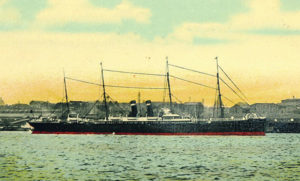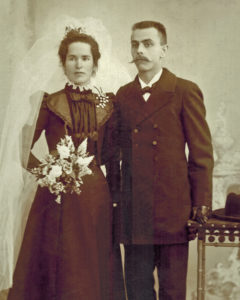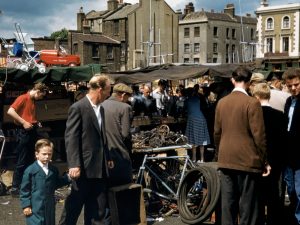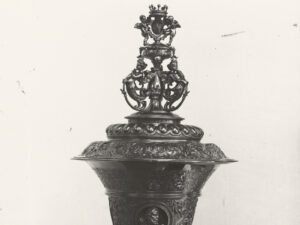
Wikimedia
The dream of a brave new world
In 1891, 19-year-old Stephanie Cordelier emigrated to the USA alone. It was an escape from her own family, and a new beginning in a whole new world.
It was a novelty for everyone: in late August 1891, the Cordelier family went to a photographer for the first time. The first thing the photographer did was provide them with new clothes: Stephanie was given a jacket with corsage, her younger brothers got proper men’s suits, and even their father Jules was given a chain that suggested a pocket watch the painter could never have afforded to buy. Even the jewellery was borrowed. Despite all the elegant disguise, their shoes betrayed the truth – that the Cordeliers were dirt-poor. The family had walked from Oberwil to the city, because they couldn’t afford the train journey. So their footwear was dusty.

The Cordeliers’ family portrait. Back: Louis, Stephanie, Jules, Jules junior. Front: Marie, Elise, Martina and Louise.
To us as observers, the image appears very staged – the clothes, the set-up of the room, the arrangement of the people. We can almost hear the photographer saying “Place your hand on your wife’s shoulder”. Jules did it – in a way that shows a total lack of connection, his hand lies across Martina’s shoulder. The detail is emblematic of the involuntary and very unhappy marriage. Martina sought solace in religion, Jules in alcohol. And Stephanie took refuge in daydreams about the New World. At 19 years of age, she finally set off to discover it for herself. Alone.
She took a train to Antwerp. There, she boarded the ‘Westernland’, a steam sailing ship that carried about 1,300 people. Upstairs, in First Class, there were luxurious salons with coloured windows and electric lights. But Stephanie travelled in steerage and slept on a straw mattress. She spent twelve days at sea. Her travel money went missing during the voyage, and only reappeared when she put on fresh clothes on the last day. On 24 September 1891, the ‘Westernland’ finally reached New York.

The emigrant ship ‘Westernland’ on a coloured postcard from 1883.
EMIGRATING WITH NO KNOWLEDGE OF THE LANGUAGE
Stephanie’s start was a difficult one. She arrived at the hopelessly overloaded Castle Garden emigrant landing depot. It was only after a seemingly endless wait that an immigration agent finally ushered her and about a dozen rather unsavoury-looking men out of the building. He led the group at a brisk pace through the dark streets of New York and took them to a ferry across the Hudson River. On board, Stephanie was sent to the ladies-only area, and lost sight of her group. She stood there for a while in the New York night, disoriented, alone and without a word of English. In the end, though, the journey to Ohio went well. Stephanie made it to the small town of Defiance, where an aunt found her a job as a servant girl and nanny for the family of an Obwalden doctor. In Defiance, she experienced a completely different family life; but in her memoires, her observations on the housework emerge as being of particular interest. How, in spring, she used pliers to take up the carpets, lugged them into the garden to beat them, and then hammered them back onto the wooden floor. How the household, including the doctor’s office, had no running water at all. And how the doctor had a parrot which, in his enthusiasm surrounding the presidential elections, he taught to squawk ‘Hooray for Cleveland!’.
Stephanie stayed in the US for five years. Then, her economic prospects darkened dramatically; Stephanie was still unmarried, and she missed her family back home. So she did something that is rarely encountered in the history of Swiss emigration: she went back. In actual fact she only intended to stay for a visit – but fate stepped in and threw her plans into disarray.
Stephanie Cordelier broke free from the stifling confines of her Oberwil childhood, and through her experiences in America became a courageous young woman who went her own, unconventional way. She rebelled against her father and, as a woman from a staunchly Catholic background, finally married a Protestant.

In 1899 Stephanie Cordelier, a Catholic, married a Protestant – a rarity at that time.



